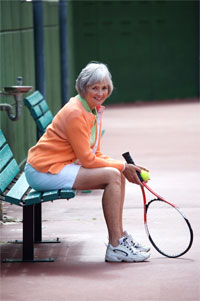
 The article focuses on seniors, who are often neglected when it comes to fitness sports. Fitness is important at any age and your golden years are no exception. In fact, neglecting the body’s health at this stage of life has a huge impact on the quality of life.
The article focuses on seniors, who are often neglected when it comes to fitness sports. Fitness is important at any age and your golden years are no exception. In fact, neglecting the body’s health at this stage of life has a huge impact on the quality of life.
From the 30s onwards, our bodies begin to take a little longer to bounce back from injuries. There is stiffness and aches and pains begin to crop up. These are signs of ageing and by the time you hit 50, there is bound to be stiffness in hip joints, the lower and mid back, and shoulder joints. This stiffness leads to a rounded posture which may leave you feeling that you don’t stand as upright and tall as you used to. This can be minimised if you concentrate on your fitness. Start with a basic medical check-up. The doctor will check your blood pressure, resting pulse rate, blood sugar levels and listen to your chest to make sure it sounds clear. Discuss any medical or orthopaedic issues with your doctor as well.
Stretch. Stretch again
Once this is done, embark on a regular, twice-a-day stretching routine. Stretching and flexibility are particularly important for seniors, as the body tends to stiffen more quickly, which is a major cause of pain.
It is better to stretch when your body is warm, so go for a brisk 15-minute walk before you start. You’ll know you are ready to stretch when you start sweating. Start stretching from your feet up, paying attention to all the muscles of the hip joints, lower and middle back and shoulder joints. Hold all stretches for 20 seconds to feel their full benefit and allow the muscles to relax fully into the stretch.
Mix it up
Once you have done the walking and stretching session regularly for a week, add another component like swimming or cycling to your fitness regime. These are low impact forms of cardiovascular training that benefit your heart, lungs, circulation and muscle endurance. Start slow and gradually increase the duration of exercise, giving your body time to adjust to the new levels of exertion.
Progress, bit by bit
I suggest you stick to the same duration for a month and then increase it by 10 per cent every month subsequently. You don’t need to do more than 45-60 minutes of cardio at a time so once you reach this limit, start working on the intensity of your training sessions instead and gradually try to increase your average heart rate per session.
Do note that you should avoid exceeding your maximum recommended heart rate, which is calculated by subtracting your age from 220 (beats per minute). For example, if you are 55 years old, the maximum heart rate you should work out at is 220 – 55 = 165 beats per minute. Also remember to stretch after each training session; never forget that for seniors flexibility is very important!
Bring in the weights
If you’re still going strong at this point, you can start a light weight training regime. The emphasis here is on getting the technique right, and using light weights for more repetitions. Your objective is not to build muscle, but to make sure you maintain a well-defined set of muscles. Do about three sets of 10-12 repetitions per exercise.
Ask a gym trainer to put together a suitable programme for you and to help you with the right technique. Pay attention to your stomach and back, as these areas weaken over time. Also pay attention to your hips and legs, to avoid joint pain.
© HT Media